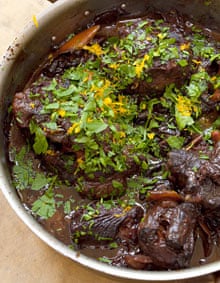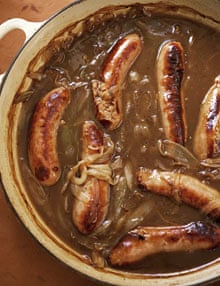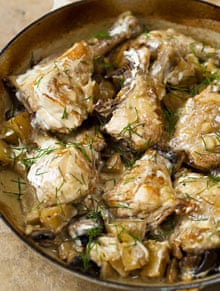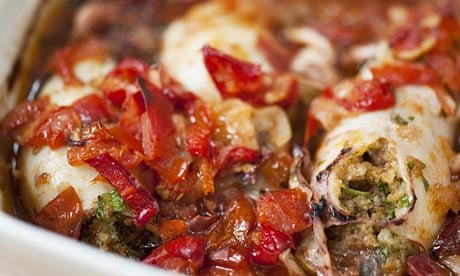The big casserole dish gets its first outing for weeks, providing a snug home for slowly cooked stews of oxtail, squid and chicken. Once the leaves start to fall, I find myself wanting food that takes its time, leaving a trail of herbal, garlicky, scents wafting through the house as it simmers its way to tenderness. Slow cooking allows us to use the cheaper cuts of meat that only show their true colours after an hour or so in a moderate oven. A lid is essential to these rich stews so the liquid doesn't boil away and the top stays moist. This autumn I have also taken to cooking root vegetables in the way of the Italian dish of pork cooked in milk, so that the dairy produce (I use yoghurt) curdles around the outside of the vegetables into little brown nuggets. It makes a good side dish for a long-cooked pork or beef recipe. Slow cooking brings us sweet, mellow flavours and tender meat and fish. For me, it's the best cooking of the year.
Baked squid with chilli tomato sauce
Ask your fishmonger to clean and prepare the squid for you, keeping each body sack in one piece ready to stuff.
Serves 4
medium to large squid 4, cleaned and prepared
For the stuffing:
breadcrumbs 150g
anchovy fillets 6
the grated zest of a lemon
flat-leaved parsley, chopped 20g
olive oil 6 tbsp
large tomato 1
For the sauce:
medium onion 1
olive oil 2tbsp
red chilli 1
large (not beefsteak) tomatoes 3
red pepper 1
vegetable stock 200ml
Put the breadcrumbs in a mixing bowl. Chop the anchovy fillets and add them to the crumbs with the zest of the lemon, the parsley, olive oil and a seasoning of salt and black pepper. Roughly chop the tomato into small dice and mix into the stuffing.
Place the squid bodies on a chopping board and stuff them using a teaspoon. Push the stuffing along the body with your fingers, getting as much as you can in without splitting the skin. Place the stuffed squid in a dish. If there is any stuffing left over scatter it over the dish. Drop the tentacles into the dish.
Set the oven at 180C/gas mark 4. Make the sauce: peel and roughly chop the onion. Leave to soften in the olive oil in a deep casserole. Halve, seed and finely chop the chilli and add to the onion. Roughly chop the tomatoes and thinly slice the pepper (discarding the core and seeds), then stir into the softening onion. Continue cooking for 10-15 minutes, with the occasional stir, until soft. Pour in the stock, season and cook for a few minutes. Spoon the sauce over the squid and bake for 45 minutes until piping hot.
Oxtail with prunes and orange
This gives two large pieces, two mediums and a couple of tail ends, the perfect quantity for two hungry people. I would have done the recipe for four, but can't imagine ever getting four offal lovers round the table at the same time.
Serves 2, with generosity
rapeseed or groundnut oil 2 tbsp
oxtail 1.3kg

large onions 2
orange 1
soft-dried prunes 200g
juniper berries a rounded tsp
red wine 500ml
To finish:
small orange 1
bushy parsley a few stalks
Set the oven at 220C/gas mark 8. Warm the oil, over a moderately high heat, in a deep casserole large enough to take the oxtail in a single layer. (I use a 24cm lidded casserole.) Add the oxtail pieces, cut side down, and cook for 4 or 5 minutes on each side until sizzling and golden brown. Remove to a bowl.
While the meat is browning, peel and roughly chop the onions. When the meat is out of the pan, add the onions and let them cook for 6 or 7 minutes over a slightly lower heat till they are pale gold and starting to soften. Return the oxtail to the pan, add four strips of peel cut from the orange, its juice, the prunes, juniper berries and the wine. Grind in a little salt and black pepper.
Turn up the heat and bring to the boil, then immediately cover with a lid and transfer to the oven. Leave to cook for 25 minutes then turn the heat down to 140C/gas mark 1 and leave to quietly putter away for a further 2 hours.
Remove from the oven, leave to cool, then refrigerate overnight. Remove the fat from the surface with a spoon and discard it. Reheat the stew thoroughly over a low to moderate heat. Finely grate the orange zest, chop the parsley; scatter over the oxtail before serving.
Slow-baked sausages
The dark brown beers give an extraordinary depth to any slow-cooked meat dish. I usually use them with beef but they also work well with pork too, including sausages – the more plump and herby the better.

Serves 4
plump pork butcher's sausages 8
a little oil
large onions 2
butter a thick slice
flour 2 lightly heaped tbsp
soft brown sugar a heaped tsp
stock (vegetable will do) 400ml
dark beer 200ml
to serve: mashed potato
Set the oven at 160C/gas mark 3. Fry the sausages using a little oil in a non-stick pan over a moderate heat till lightly coloured on all sides. Remove from the pan. Peel the onions and slice them thinly into rounds. Melt the butter in a pan over a moderate heat, add the onions and let them colour lightly. Stir in the flour. Cook for 3 or 4 minutes, stirring from time to time, then add the sugar, stock and beer and bring to the boil. Let the mixture boil for a minute or so, then cover with a lid. Bake for 50 minutes, then serve with mashed potato.
Parsnips with cardamom and yoghurt
I love the way the yoghurt curdles into tiny grains and clings to the parsnips in this recipe. I have eaten it as a main dish with steamed brown basmati, but it would also make a good side order for pork chops or escalopes.

Serves 2-4
parsnips 650g
large onion 1
green cardamom pods 8
knob ginger 60g
rapeseed oil 3 tbsp, plus a little extra
cinnamon stick 1
cumin seeds 1 tsp
cloves 2
ground coriander ½ tsp
yoghurt 300ml
coriander leaves a small handful

Set the oven at 160C/gas mark 3. Peel the parsnips, chop them roughly and put them on to boil or steam for 10 minutes. Drain and set aside.
Peel and thinly slice the onion, break open the cardamom pods and crush them lightly to a coarse powder with a heavy weight. Peel and shred the ginger into matchsticks. Warm 3 tbsp oil in a heavy casserole over a low to moderate heat, add the onions, cardamom, ginger, cinnamon stick, cumin, cloves and ground coriander, adding a little more oil if necessary. Cook for 5 minutes or until the onion starts to soften and the spices smell fragrant.
Put in the drained parsnips and let them colour, adding a little more oil if the mixture looks a little dry. Season generously with salt and black pepper. Pour in the yoghurt, stir lightly, then cover with a lid and bake for an hour till the yoghurt has thickened and is clinging to the parsnips in small lumps. Add coriander leaves, torn or chopped.
Chicken with potatoes and dill
A mild treatment for chicken with soft, autumnal flavours. Steamed rice, possibly brown basmati, works nicely.
Serves 4
chicken 1, jointed into 8 pieces
butter 30g
olive oil 1 tbsp
small chestnut mushrooms 250g
small potatoes 400g
cider 500ml
double cream 150ml
dill a small bunch
Melt the butter in a casserole, add the oil then, when it starts to sizzle, put in the chicken. Season with salt and pepper, then leave to cook over a moderate heat, until the chicken is pale gold on both sides. Remove the chicken from the pan and set aside.
Cut the mushrooms in half or quarters depending on their size and add to the pan. Let them soften, adding more butter or oil if necessary. Scrub and halve or quarter the potatoes. Add them to the pan and leave till lightly coloured, then pour in the cider. Return the chicken to the pan and bring to the boil, lower the temperature so that the liquid simmers gently.
Leave the chicken to cook, covered with a lid, for 30-45 minutes or until it is cooked right through. Check by pushing a skewer into the thickest part – if the juices run clear it is cooked.
Stir in the cream and chopped dill, wait a minute or two, then serve.
